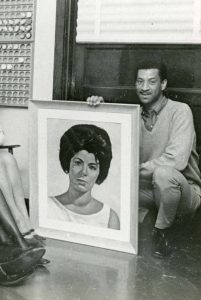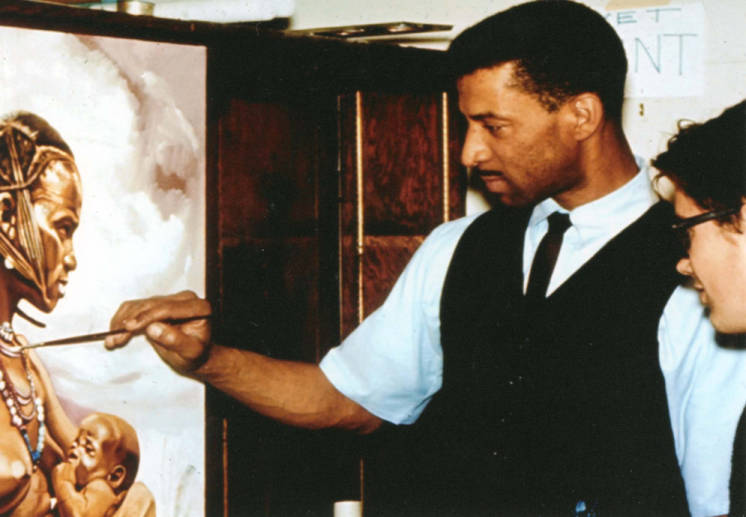
Photo info ...
Credit: Indianapolis-Marion County Public LibraryView Source
(Nov. 6, 1927-June 30, 1990). Joe Holiday was born in Chicago, Illinois, the seventh of eight children of Joseph and Gussie Hunt Holiday. Holiday’s father died when he was two years old, after which the family moved to Indianapolis where Holiday resided until his death.
Holiday may have heard stories about his father’s creativity that would inspire his artistry much later in life. As a cabinet maker, Holiday’s father fashioned ornate designs in wood and painted glass. As an adult, the younger Holdiay would go on to create frames for his own artwork, fashioning some of the more unusual pieces from ornate headboards and rough weathered wooden planks.
In Indianapolis, Holiday created his first pencil drawing at age 5 and sold his first pencil sketch at age 6 to neighbors. Later, at , Holiday’s teachers encouraged his creativity and made it possible for him to attend the in Indianapolis. He also studied at the Art Institute of Chicago.

Holiday lived and worked at his home studio on North Illinois Street in Indianapolis. He is known for his facial studies, particularly of African Americans and Africans. Most of his work is in oil where he uses a palette knife and brush, though some of his work shows his skill using pastels.
Rather than using live models to guide his painting, Holiday preferred to study slides of photos his brother took from his travels to Africa to channel inspiration for his creations. Holiday said of his work, “I constantly observe people . . . and when I paint, I try to capture the moods and feelings I see.” Portraiture did not appeal to Holiday. He viewed it as a reductive task rooted in achieving a likeness of the subject rather than an expression of the subject’s mood.
Holiday drew inspiration for his combination of realism and mood by studying the art of Andrew and Jamie Wyeth and Norman Rockwell. Though Holiday’s subject matter remained constant throughout his career, his artwork continued to mature as he studied the techniques of Michaelangelo and DaVinci from his ample collection of art history books.
Holiday participated in many one-man shows partly because Indianapolis had few opportunities and spaces where up-and-coming artists, let alone Black artists could display their work in the 1960s. The limited number of commercial and nonprofit galleries tended to work with established artists. Those galleries that existed were located on Indianapolis’ Old Northside and the burgeoning art colony in Broad Ripple (See ).
However, he did find venues to showcase his work. For example, he exhibited and won prizes at the . In the late 1960s, his work was displayed in the lobbies of Indianapolis theatres and businesses. U.S. state senator Rupert Vance Hartke (D-IN) hung a Holiday painting in his Washington, D.C., office as did an unidentified U.S. state representative from Indiana.
Limited exposure of Holiday’s work combined with the economic price-point of his paintings, most of his oil paintings listed at a starting price of $75 and the pastels at $25, may have made full-time dedication to art untenable. He taught art in the program services department at the Camp Atterbury Job Corps Center in 1970. Later he taught art at Holy Angels Schools.
In fact, only a handful of artists who graduated from Herron School of Art in the 1980s successfully fashioned a career solely in their artwork. Most artists teach, do design work, or have other sources of income.
In February 1988, the kicked off its promotion of Black History month with an exhibition of some of Holiday’s artwork. The library’s artist-in-residence, Anthony Radford, took inspiration from the exhibit to organize the annual event that highlights the work of Indianapolis’ African American creatives.
During his career, Holiday produced between 300 to 400 works of art. After his death in 1990, organizers honored Holiday, displaying some of his key artwork. Holiday’s work continues to be shown retrospectively at the Meet the Artists event it inspired.

Help improve this entry
Contribute information, offer corrections, suggest images.
You can also recommend new entries related to this topic.